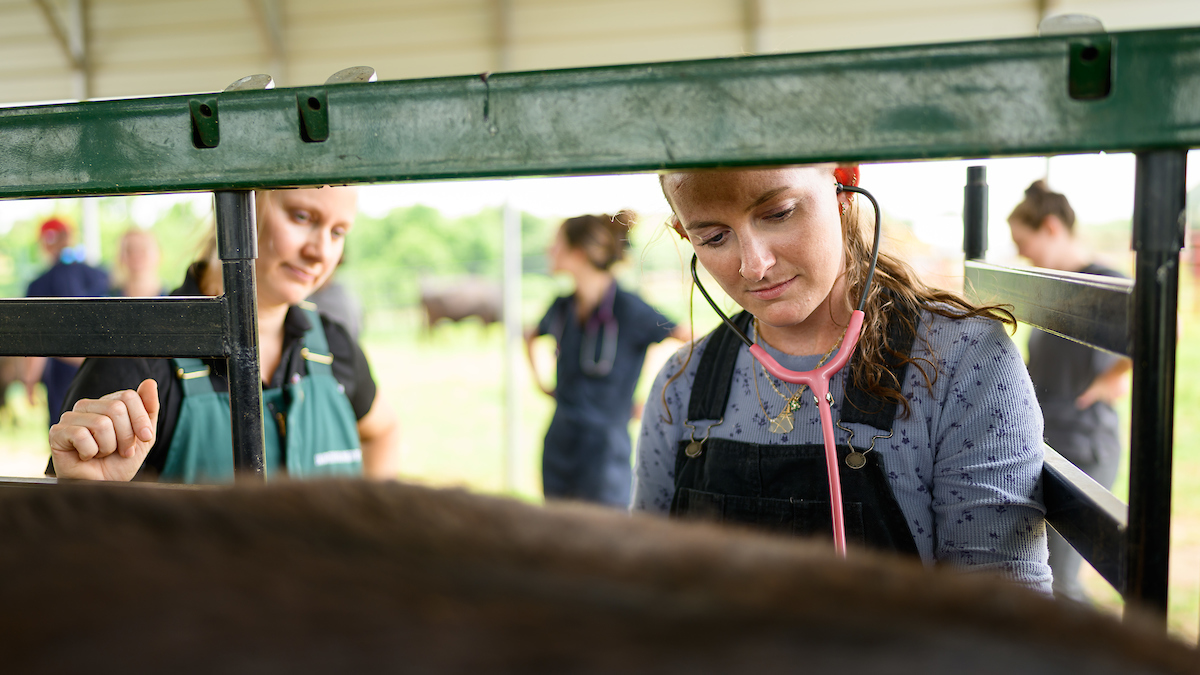CVM Research Helps Find Gene Responsible for Neurodegenerative Disease
A researcher in North Carolina State University’s College of Veterinary Medicine has helped to locate and identify a gene responsible for a fatal neurodegenerative disease that affects American Staffordshire terriers. This same gene may be responsible for a similar rare, fatal disease in humans. Its discovery will lead to improved screening and diagnosis of the disease in dogs and is the first step in working toward a cure for both canines and humans.
Dr. Natasha Olby, associate professor of neurology in the Department of Clinical Sciences, was part of a multi-national team of researchers who located the gene responsible for a variant of neuronal ceroid lipofuscinoses (NCL), a family of diseases that result in mental and motor deterioration – and eventually death – in the dogs.
The team’s results were published in the Aug. 17 issue of the Proceedings of the National Academy of Sciences.
NCLs, while rare in humans, are most common in children, although an adult-onset form of the disease – known as Kufs’ disease – does occur. In this adult disease, neurons within the brain gradually die, causing loss of vision, epilepsy, dementia and loss of coordination.
Dr. Olby saw the first case of a canine version of adult-onset NCL in American Staffordshire terriers in 2000. Over subsequent years, she found that the disease was a widespread and hereditary problem within the breed, affecting one of every 400 registered dogs. The disease kills the neurons in the cerebellum, which controls balance. Over time, the cerebellum shrinks, motor control deteriorates, and the patient dies or is euthanized.
“The disease became so prevalent because it was a recessive disease with a late onset,” says Dr. Olby. “Carriers of a single copy of the mutated gene never develop symptoms, and dogs with two copies of the gene might not show symptoms until five or six years of age, so the mutation was able to take hold in the breeding population.”
Through genetic analysis, the research group was able to locate the specific gene – an entirely novel mutation that has not been reported in people. According to Dr. Olby, the novel nature of the mutation means that researchers can now test samples from humans with NCL to determine whether this same mutation causes Kufs’ disease in people.
“The canine disease is a good model of the adult human form of the disease,” says Dr. Olby. “We hope that this discovery will provide insight into the development of this disease.”
The Department of Clinical Sciences is part of NC State’s College of Veterinary Medicine.
-peake-
Note to editors: An abstract of the paper follows
“A canine Arylsulfatase G (ARSG) mutation leading to a sulfatase deficiency is associated with neuronal ceroid lipofuscinosis”
Authors: Marie Abitol, Unite Mixte de Recherche 955 de Genetique Fonctionnelle et Medicale, Institut National de la Recherche Agronomique; Jean-Laurent Thibaud, United Propre de Recherche de Neurobiologie, Unisersite Paris-Est Ecole Nationale Veterinaire d’Alfort; Natasha Olby, North Carolina State University; et al
Published: Aug. 17, 2010, in Proceedings of the National Academy of Sciences
Abstract:
Neuronal ceroid lipofuscinoses (NCLs) represent the most common group of inherited progressive encephalopathies in children. They are characterized by progressive loss of vision, mental and motor deterioration, epileptic seizures, and premature death. Rare adult forms of NCL with late onset are known as Kufs’ disease. Loci underlying these adult forms remain unknown due to the small number of patients and genetic heterogeneity. Here we confirm that a late-onset form of NCL recessively segregates in US and French pedigrees of American Staffordshire Terrier (AST) dogs. Through combined association, linkage, and haplotype analyses, we mapped the disease locus to a single region of canine chromosome 9. We eventually identified a worldwide breed-specific variant in exon 2 of the Arylsulfatase G (ARSG) gene, which causes a p.R99H substitution in the vicinity of the catalytic domain of the enzyme. In transfected cells or leukocytes from affected dogs, the missense change leads to a 75% decrease in sulfatase activity, providing a functional confirmation that the variant might be the NCL-causing mutation. Our results uncover a protein involved in neuronal homeostasis, identify a family of candidate genes to be screened in patients with Kufs’ disease, and suggest that a deficiency in sulfatase is part of the NCL pathogenesis.
Posted August 23, 2010


